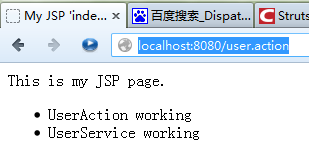SSH框架学习(三、在struts基础上加入spring)
spring现在的版本是3.1.3,下载地址http://www.springsource.org/spring-framework#download
spring的包里面没有提供例子,额,这点不如struts。
1、导入包。
首先需要添加struts的spring插件:struts2-spring-plugin-2.3.7.jar
其次,spring还需要一个外部的jar:commons-logging-1.1.1.jar,下载地址http://commons.apache.org/logging/download_logging.cgi
在这里,spring只需要以下几个jar
2、新建packa:demo.myssh.business,添加UserService类。
package demo.myssh.business;
public class UserService {
public String doing()
{
return "UserService working";
}
}
3、为了让UserService能够注入到UserAction,还需要为UserAction添加注入用的属性和方法
package demo.myssh.action;
import com.opensymphony.xwork2.ActionSupport;
import demo.myssh.business.UserService;
@SuppressWarnings("serial")
public class UserAction extends ActionSupport {
@Override
public String execute() throws Exception {
this.addActionMessage("UserAction working");
// this.addActionMessage("hello world.");
this.addActionMessage(userService.doing());// 修改下,确认注入成功。
return ActionSupport.SUCCESS;
}
// 注入用属性
private UserService userService;
// 注入用的方法
public void setUserService(UserService userService) {
this.userService = userService;
}
}
4、在web.xml文件中加入spring的监听器
<?xml version="1.0" encoding="UTF-8"?> <web-app version="3.0" xmlns="http://java.sun.com/xml/ns/javaee" xmlns:xsi="http://www.w3.org/2001/XMLSchema-instance" xsi:schemaLocation="http://java.sun.com/xml/ns/javaee http://java.sun.com/xml/ns/javaee/web-app_3_0.xsd"> <display-name>myssh</display-name> <filter> <filter-name>struts2</filter-name> <filter-class>org.apache.struts2.dispatcher.ng.filter.StrutsPrepareAndExecuteFilter</filter-class> </filter> <filter-mapping> <filter-name>struts2</filter-name> <url-pattern>*.action</url-pattern> </filter-mapping> <!-- 加入spring的监听器 --> <listener> <listener-class>org.springframework.web.context.ContextLoaderListener</listener-class> </listener> <welcome-file-list> <welcome-file>index.jsp</welcome-file> </welcome-file-list> </web-app>
5、修改struts.xml文件
<?xml version="1.0" encoding="UTF-8" ?> <!DOCTYPE struts PUBLIC "-//Apache Software Foundation//DTD Struts Configuration 2.3//EN" "http://struts.apache.org/dtds/struts-2.3.dtd"> <struts> <package name="mysshdemo" extends="struts-default"> <action name="user" class="userAction"> <result>/index.jsp</result> </action> </package> </struts>
<?xml version="1.0" encoding="UTF-8"?>
<beans xmlns="http://www.springframework.org/schema/beans"
xmlns:xsi="http://www.w3.org/2001/XMLSchema-instance"
xsi:schemaLocation="http://www.springframework.org/schema/beans
http://www.springframework.org/schema/beans/spring-beans-3.0.xsd">
<bean id="userAction" class="demo.myssh.action.UserAction">
<property name="userService" ref="userService" />
</bean>
<bean id="userService" class="demo.myssh.business.UserService"></bean>
</beans>
这时候访问:http://localhost:8080/user.action
到此,基本的struts2+spring3搭建完成。
要点:这里有3个对应关系一定要注意
1、struts配置文件中,action的class属性要对应到spring配置文件中的bean的id,这样,struts就只负责传递,而所有servlet都有spring来管理。
我试过,struts.xml中,
不用<action name="user" class="userAction">
用<action name="user" class="demo.myssh.action.UserAction">也能正常运行。但是奇怪的是我之前如果这么用就无法注入。不确定是struts版本的问题还是哪里的问题。
个人理解,如果class里面配置的是个id,那么,action将有spring来直接管理。如果class里面配置的是类名,则action将有struts来处理。
推荐还是将action交给spring来管理的好,逻辑上更清晰,也不容易出现奇怪的问题。
2、spring配置文件中,注入类不是直接使用其类名,而是通过bean的id来获取。要注入哪个类,就在ref中填入那个的bean的id。
3、spring配置中注入属性的名称必须和java类里的属性名一致,并且,该属性还要提供set方法。




